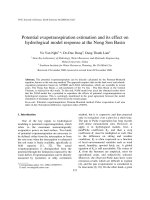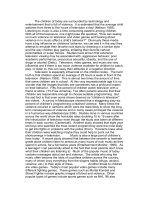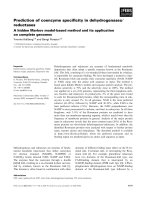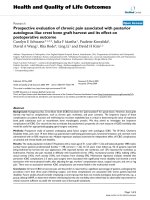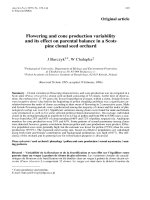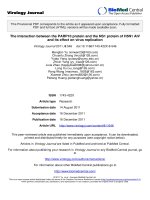MI BASED TEACHING AND ITS EFFECT ON EFL HIGH SCHOOL STUDENTS’ AUTONOMY
Bạn đang xem bản rút gọn của tài liệu. Xem và tải ngay bản đầy đủ của tài liệu tại đây (1.07 MB, 136 trang )
MI-BASED TEACHING AND ITS
EFFECT ON EFL HIGH SCHOOL
STUDENTS’ AUTONOMY
BY
DUONG THI THANH
A thesis submitted to Vinh University in fulfillment of the
requirements for the degree of Master of Art
Vinh University, 2017
ABSTRACT
This study aims to look at the application of Multiple Intelligences
(MI) Theory in teaching EFL to high school students in order to
examine the relationship between MI-based teaching and EFL high
school students’ English proficiency and learning autonomy. An
experiment was carried out among sixty high school students, who
were divided into two groups (control and treatment). Both of the
groups did a general English test and the pre-treatment autonomy
test before the experiment and a general English test and posttreatment autonomy test after the experiment. The tests were
designed to assess the participants’ English proficiency and learning
autonomy. During the experiment, only the treatment group was
taught with the MI-based approach. The data indicated that the
treatment group obtained better results in English proficiency and
learning autonomy than the control group. Based on the research
findings, implications for English language teachers and students
were also proposed.
I would like to express my deep gratitude to my supervisor, Dr. Tran Thi Ngoc
Yen, who I believe is the most wonderful supervisor, for her valuable directions,
precious orientation, warm stimulation, and continuous support throughout this
project. Her enthusiasm and positive attitudes were sparkling in such a way that
it helped to make my research a serious yet fun task to fulfil.
I am grateful to Nguyen Thi Nga, an English teacher at Thanh Chuong 3 high
school in Thanh Chuong district, Nghe An province, for helping me teach MIbased lessons at her classes as well as gather the data for the research; and Phan
Thi Hoa, for copying the documents, materials for my experiments quickly.
I would also like to thank the administrators, teachers, and students at Thanh
Chuong 3 high school in Thanh Chuong district, Nghe An province for their
cooperation and support.
Finally, I would like to delicate this work to my parents and family, particularly
my husband, all of whom have been always supporting me with love and
sympathy.
3
iii
4.1
4
4.2
4.3 Chart 4.1 The percentage of different scores on the pre-test in the control
4.4
4.5
CHAPTER 1
INTRODUCTION
1.1 Rationale
4.6
The autonomy plays a principal role in achievement in all of the levels
from primary school to university. Therefore, numerous studies have been
conducted in this issue with the aim of fostering students’ autonomy. Studies
have indicated that teachers need to equip themselves with more flexible
approaches (Galton & Eggleston, 1979; Nelson, 1996) for learning effectively.
The idea of Multiple Intelligences has attracted the sizeable interest of many
educators as well as the general public. Schools that use MI theory encourage
learning that goes beyond traditional books, pens, and pencils. Mi-based
teaching is the way of teaching to help students reach their potential. However,
there has not any research in using MI in order to stimulate the learner’s
autonomy. MI is still relatively new in Vietnam although this concept has been
studied since 1983 in Frame of Mind: The Theory of Multiple Intelligences.
Because of its newborn appearance even though it shows striking compatibility
with traditional Vietnamese education models. The application of this model in
English language teaching to develop students’ autonomy has been studied.
This research was written with the purpose of determine whether MI-based
teaching has any effects on learner autonomy and students’ English proficiency.
4.7
There have been many researchers who notice the importance of MIbased teaching in stimulating students to learn better as well as fostering
learner autonomy. Richard and Rodgers (2001: 120) stated “The MI
classroom is one designed to support development of the „whole
person’, and the environment and its activities are intended to
enable students to become more well-rounded individuals and
more successful learners in general. Learners are encouraged to
see their goals in these broader terms.” In addition, Christison
(1997:9) also emphasized MI’s vital role to learner autonomy, he claimed
“The more awareness students have of their own intelligences and
how they work, the more they will know how to use that
intelligence to access the necessary information and knowledge
for a lesson”
6
4.8
There is much evidence that influence schools influenced by MI theory
are effective (Gardner, 2006: 83) and with understanding of theory teachers can
better understand learners. They can allow students to safely discover their
strengths, learn in many ways and they can help their students to be in control
of their own learning (Guignon, 1998, March 12). Nevertheless, nowadays,
students have not almost had full awareness about the importance of autonomy.
Most of them learn because they are forced to learn. Besides, the traditional
teaching method always focuses on grammar, vocabulary, reading and ignores
important parts such as listening, speaking and pronunciations. As a result, the
lesson is really boring. Particularly, this teaching method focuses on teachers or
centered-teacher teaching, or other words, teachers are the center of teaching
and learning process, students only listen so students are extremely passive in
learning. From these above reasons, I wonder whether IM-based teaching can
help students develop learner autonomy and English proficiency. This is the
reason why I choose this major to study and make experiments. In this study, I
really hope to make a minor contribution to improve the students’ autonomy.
1.2 Aims of the study
4.9
The aim of this study was explore different perspectives of MI-based
teaching method on high school students’ learner autonomy. It was set out to
examine the impacts of MI teaching on learners’ autonomy and EFL high
school students’ English proficiency.
1.3 Research questions
4.10
The study was conducted to seek the answers for the following
questions
-
Will MI-based teaching help to develop EFL high school students'
autonomy?
-
How does MI-based teaching affect EFL high school students’ English
proficiency?
1.4 Scope of the study
4.11
With the aim of discovering the effect of MI-based teaching on EFL
learners’ autonomy, a survey was conducted to collect the needed data from the
learners.
4.12
Sixty students of a high school in Nghe An province were involved in
this study.
4.13
2
1.5 Thesis design
4.14
The thesis consists of five chapters.
4.15
Chapter 1 is the introduction, which provides a brief introduction,
rationale and an overview of the thesis.
4.16
Chapter 2 is the literature review, in which previous research about MI
quizzes, MI in education, MI in teaching and learning was presented. In
addition, autonomy’s role and principles as well as accessing and developing
autonomy will be discussed carefully.
4.17
Chapter 3 introduces the research methodology of the study. It provides
information about the materials, participants, instrument for data collection,
research procedures and data analysis.
4.18
Chapter 4 presents the detailed results and discussions developed after
the impacts analyzed.
4.19
Chapter 5 contains the implications and conclusions. This chapter
summarizes the main issues touched upon in the research, the limitations of the
research and some suggestions for further studies. Following the chapters are
the references and appendices.
1.6 Methodology
4.20
The main methodology used in the project was experimental. Groups of
high school students, the control group and the treatment group in Thanh
Chuong were involved in the study.
4.21
The study is intended to measure students’ autonomy as well as to see
benefits of MI-based lessons with learners’ autonomy. Using MI-based lessons
to improve learners’ autonomy is effective or not.
4.22
This chapter presents a brief review of the literature on the topics that
are generally related to the research in this thesis. Previous studies on the MI
quizzes, MI in education, MI in teaching and learning. In addition, autonomy’s
role and principles as well as accessing and developing autonomy will be
discussed.
2.1 Multiple Intelligences
4.23
Gardner and Armstrong set the stage for exploring the many ways MI
theory which is applied in educational settings around the world. Numerous
great people, researchers, educators, and teachers around the world are
working seriously to apply MI theory, MI-based activities in the lessons as
well as educational activities in order to improve the education and make the
learning periods become more interesting, particularly make learners more
interested in the lessons.
4.24
The theory about MI has important implications for teaching in general
and for language learning in particular. (Armstrong 2007; Azar 2006; Buchen
2006; Campbell & Dickinson 2004; Christian 2004; Fogarty & Stoehr 2007;
Tracy & Richery 2007; Viens & Kallenback 2004; Barrington 2004; Chan
2006; Christion & Kennedy 2004; Hall 2004).
4.25
Gardner defines intelligence as “the ability to process information that
is activated in a cultural contest for problem solving or creating products
which are worthy in a culture” (Gardner 1999, p. 33). According to him, MI
has been influential in language teaching circles. Teachers who recognize the
multiple intelligences of their students acknowledge that students bring with
them specific and unique strengths, which are often taken into account in
classroom situations.
4.26
Gardner claims that all human beings have multiple
intelligences in varying
4.27
amounts. Each person has a different intellectual profile. These
intelligences are located in different parts of the brain and can either work
independently or together. These intelligences can be nurtured and
strengthened, or ignored and weakened. According to Gardner, we can
improve education by addressing the multiple intelligences of our students.
Gardner (1999) identifies not two, but nine different intelligences: linguistic,
logical mathematical, spatial, bodily- kinesthetic, musical, interpersonal,
intrapersonal, naturalist, and existential. Gardner defined the first seven
intelligences in Frames of Mind (1983). He added the last two in Intelligence
Reframed (1999).
4.28
The nine Kinds of Intelligences proposed by Gardner are as follows
1) Linguistics (called Word Smart): The capacity of using a word
effectively whether orally or in writing and language to express and
appreciate complex meanings. This intelligence includes the ability to
manipulate the syntax or structure of a language, the semantic or
meaning of a language, and the pragmatic or practical use of a
language. There are some characteristics about this intelligence for
example the ability of learning other languages; enjoying reading,
writing and discussing; remembering what have been said or read;
speaking and writing effectively. Linguistic intelligence is the most
widely shared human competence and is evident in poets, novelists,
journalists, and effective public speakers. Young adults with this kind of
intelligence enjoy writing, reading, telling stories or doing crossword
puzzles. Their suitable occupations are poets, novelists, journalists, and
effective public speakers, lawyers, linguistics, PR and media
consultants, teachers, translators TV and radio presenters, voice-over
artists, writer.
2) Logical-Mathematical (called Number/Reasoning Smart): The capacity
of using numbers effectively as well as calculating, quantifying,
considering propositions and hypothesizing, and carrying out complete
1
1
mathematical operations. This intelligence includes sensitivity to logic
patterns and relationship. Logical-Mathematical intelligence is usually
well developed in mathematicians, scientists, and detectives. It is
familiar with the concepts of quantity, time, and cause and effect.
Abstract symbols are used to represent concrete objects and concepts.
Liking math and using technology to solve complex problems. The
people whose logical intelligence are interested in patterns, categories,
and relationships and their favorite careers are analysts, arbitrators,
bankers,
certified
public
accountants,
computer
programmers
accountants, engineers, insurance brokers negotiators, researchers,
scientists, statistician and traders.
3) Spatial (called Picture Smart): The ability to perceive the visual-spatial
word accurately. This intelligence involves sensitive to color, line,
shape, form, space, and the relationship that exist between these
elements. It seems to learn by seeing and observing such as objects,
faces, details and scenes as well as use visual images as an aid to recall
information. Major capacities include mental imagery, spatial
reasoning, image manipulation, graphic and artistic skills, and an active
imagination. Some careers such as sailors, pilots, sculptors, painters,
and architects, architects, artists, cartographers, city- planners,
engineers, graphic designers, landscape architects, photographers,
sculptors all exhibit spatial intelligence. People with this kind of
intelligence seem to be fascinated with mazes or jigsaw puzzles, or
spend available time drawing or daydreaming.
4) Bodily-Kinesthetic (called Body Smart): Expertise in using one’s whole
body to express idea and feeling and facility in using one’s hands to
produce or transform things. It is the capacity of manipulating objects
and using a variety of physical skills such as being good at concrete
learning experiences such as field trips, model building, or participating
in role play, games, assembling objects, or physical exercise as well as
1
2
the ability of demonstrating skills in acting, athletics, dancing, sewing,
carving or keyboarding. Some careers such as athletes, biologists,
dancers, geologists, instrumentalists, nurses, physical education
teachers,
physical
therapists,
physicians,
actors,
sign-language
interpreters exhibit this kind of intelligence.
5) Musical (called Musical Smart): The capacity to perceive, transform,
and express musical forms. Expressing interest to a variety of sounds
including the human voice, environmental sounds, and music, and
organizes such sounds into meaningful patterns. Being eager to be
around and learn from music and musicians. Learners seem to learn
most effectively when they use sounds or music to do the exercises or
homework. Moreover, they have the special ability of music such as
composing the songs, singing the songs. On the other words, musical
intelligence is the special capacity to discern pitch, rhythm, timbre, and
tone. This intelligence enables us to understand, recognize, create,
reproduce, and reflect on music and rhythm. The appropriate
occupations for the young adults whose musical intelligences are
composers,
conductors,
musicians,
vocalist,
judges’
musical
competitions and sensitive listeners, DJs, entertainers, environment and
noise analysts, music producers, musical instrument repair specialists,
musical performers, singers, voice coaches.
6) Interpersonal (called People Smart): The ability to perceive and make
distinctions in the moods, intentions, motivations, and feeling of other
people. It also is the capacity of understanding, communicating and
interacting effectively with other Working and cooperating with other
partners effectively are the great strengths from the interpersonal
intelligences and they seem to be easy to become leaders among their
peers, are good at communicating, and seem to understand others’
feelings and motives. The people whose interpersonal intelligence would
like to work with various people in groups, teams or pairs. Expressing an
1
3
interest in interpersonally-oriented careers such as teachers, social
workers, consultant, managers or politicians, advertising professionals ,
care givers, coaches and mentors, counselors, educators, health
providers, HR professional mediators, psychologists, sales-people,
therapists, trainers.
4.29
Intrapersonal (called Self Smart): Self-knowledge and the
ability to act adaptively on the basic of that knowledge. This
intelligence includes having an accurate picture of oneself,
awareness of inner mood, intentions,
1
4
4.30
motivations, temperament and desires as well as use this knowledge in
planning one’s life. The people whose interpersonal intelligences seem to work
on their own rather than with others and obviously, they are easy to get better
results when doing individually in comparison with cooperating with other
partners. Psychologist, spiritual leaders, and philosophers may be really
appropriate for the people’s intrapersonal intelligence.
7) Naturalist (called Nature Smart): having ability of recognizing and
classify of the numerous species of an individual’s environment
(Armstrong, 2008, pp. 6-7) as well as having an interest in and good
knowledge of how the body works and keeps abreast of health issues.
The more special thing is the ability of “read” weather signs. Moreover,
having an understanding of, and interest in are the main global
environmental issues. It is the human ability to discriminate among
living things such as plants and animals as well as sensitivity to other
natural features of the natural world for example clouds and rock
configurations.
8) Existential Intelligence
4.31
Existential intelligence is sensitivity and capacity to tackle deep
questions about human existence, such as the meaning of life, why do we die,
and how did we get here.
2.1.1
4.32
The definitions
Up to now, there have been various definitions about MI, for learners MI
are abilities to do something effectively, especially in learning English as
second language. Discussing about the vital role of MI, Gardner (1983) states
as “the ability to solve problems or to create products that are valued within
one or more cultural settings
4.33
MI-based teaching usually concentrates on students’ unique abilities,
which is
4.34
reported by Richard & Rodgers (2001: 123) that MI approach has
been grown
4.35
in the increasing popularity to characterizing the ways which learners
are
4.36
unique and to developing instruction to respond to this uniqueness.
Moreover
4.37
8
4.38
MI is considered one of a set of such perspectives dealing with learner
differences and borrows heavily form these in its recommendations and designs
for lesson planning.
4.39
Having discussions about MI theory Barrington (2004); Kornhaber,
Fierros, and Veenema (2004); Cohen & Weaver (2004); Curtin (2005); Mitchel
& Myles (2006); Oxford, Cho, Leung, & Kim (2004); Oxford & lee (2008)
stated that MI theory can be a new and effective method for presenting different
strategies of teaching and can help students achievements ameliorated.
4.40
Gardner describes intelligence as “the ability to process information that
is activated in a cultural contest for problem solving or creating products
which are worthy in a culture” (Gardner 1999, p. 33). Richard and Rodgers
(2001) define MI theory as a way that not only has been attended to in public
instruction but also in teaching English and its application in teaching English
is recent and new (p. 117).
4.41
According to Gardner (1999a), intelligence is the ability to create an
effective product or offer a service that is valued in a culture, is a set of skills
that make it possible for a person to solve problems in life, and is the potential
for finding or creating solutions for problems, which involves gathering new
knowledge.
4.42
MI theory can be a new and effective method for presenting different
strategies of teaching and learning as well as can help students get
achievements. (Barrington 2004; Kornhaber, Fierros, and Veenema 2004;
Cohen & Weaver 2004; Curtin 2005; Mitchel & Myles 2006; Oxford, Cho,
Leung, & Kim 2004; Oxford & lee 2008).
2.1.2
4.43
MI quizzes
The Multiple Intelligence quizzes’ aim is to measure the learners’
intelligences including verbal (linguistic), visual logical, musical, kinesthetic,
17
interpersonal,
intrapersonal
and
naturalistic
intelligences.
With
each
intelligence, there are
4.44
different activities and quizzes to measure learners’ intelligences.
4.45
In order to examine the Linguistic Intelligence, numerous activities are
conducted including writing a set of instructions; speaking on a subject; editing
a written piece or work; writing my own story, a speech, a passage, a essay or
even an article; commentating on an event; applying positive or negative 'spin'
to a story as well as being able to learn other languages; even composing a
poem. Moreover, spending great time on reading books, newspapers and
playing word games or crosswords
4.46
According to Gardner (1983), Logical-Mathematical Intelligence
provides us the ability to use the numbers as well as to understand the
principles of a logical system. This intelligence is presented in performing a
mental arithmetic calculation; creating a process to measure something
difficult; analyzing how a machine works; devising a strategy to achieve an
aim; assessing the value of a business or a proposition; expressing in careers
such as accounting, computer, technology and law as well as using abstract
symbols to represent concrete subjects and concept. Armstrong (1999: 99)
recommends several tactics used in solving problem “find analogies; separate
various part of a problem; propose the possible solution and then work
backward".
4.47
Musical Intelligence is the ability perceives and appreciates the rhythm,
pitch and melody. This intelligence is shown in listening and responding with
the interest to a variety of sounds including the human voice, environmental
sounds, and music, and organizes such sounds into meaningful patterns;
performing a musical piece; singing a song; reviewing a musical work;
developing the ability to sing or play the musical instruments; specifying mood
music for telephone systems and receptions. Up to now several researchers
have studied about the effects of music in classroom such as Rauscher, Shaw
18
and Ky (1997), Benenzon (1995). It can be seen that development of musical
intelligence in the classroom can help students concentrate more, stimulate the
creative process and foster the relaxation.
4.48
Bodily-Kinesthetic Intelligence refers to the ability to use the body to
express yourself for example; gestures are movements of to communicate an
idea, intention or feeling. Other activities are involved including role plays,
drama, games, project work, model building or physical exercises. This
intelligence is performed in demonstrating skill in acting, athletics, dancing,
and sewing, carving or keyboarding. Phenix (1964:165) explains about the
importance of movement in every human activity “To be alive is able to
respond to be moved and to move. All perceptions of surrounding world are
accompanied by motor reactions. No instrument is as elaborative, sensitive and
responsive as the human body”. Kellerrnan (1992) proposed the use of videorecorded interactions in order to improve listening comprehension skill.
4.49
The Spatial-Visual Intelligence is the ability to perceive all of the
elements including shape, size, form, color, line and space which are very
necessary to create metal images of something. This ability is learned through
seeing and observing as well as visual images are used to a aid in recalling
information. Many activities are proposed for the Spatial-Visual Intelligence,
for instance designing a costume; interpreting a painting; creating a room
layout , a corporate logo; designing a building; packing a suitcase or the boot of
a car and reproducing objects in visual form. The view of Tomlinson (1998)
about the relationship between reading comprehension and metal images was
that when metal images are used systematically they will become a remarkably
useful strategy, because the visualizing while trying to understand a context is
really important for meaning making.
4.50
Interpersonal Intelligence is the ability to understand other people’s
perspectives, to harmonize with others, to work cooperatively and communicate
effectively as well as to convince others in order to achieve personal purposes.
Hymes (1971) and Canale and Swain (1980) supposed that language learning is
19
a social process which has a main goal of development communicative
competence. Vygotsky (1978) emphasized that learning is shaped and
influenced by social interactions. Casal (2002), who had a total agreement
about application in the classroom, proposed that cooperative learning is a good
method which helps to develop this intelligence in language classroom. Some
activities are used to examine this intelligence such as interpreting moods from
facial expressions; demonstrating feelings through body language; affecting the
feelings of others in a planned way; coaching or counseling another person;
forming and maintaining the social relationship. Besides it is the ability of cooperate and co-work with other people with several other activities for instance
working in groups, teams or pairs.
4.51
Intrapersonal Intelligence gives us the capacity to understand the internal
aspects of the self and to practice the self-discipline. Understanding your
capacity and limitation to optimize personal performance is one of tremendous
opportunities of learning style research applied to language learning
(Christison, 1999; Reid, 1995, 1998). Language learning tasks for this ability
including asking learners to think the color, size and texture which express their
feeling or reading activities where students to develop their attitude towards a
problem (Robles, 2002). There are numerous activities relating to Intrapersonal
Intelligence, for instance, considering and deciding one's own aims and
personal changes required to achieve them (not necessarily reveal this to
others); and deciding options for development; considering and decide one's
own position in relation to the Emotional Intelligence model (being aware of a
wide range of emotion); identifying and pursuing one’s goals.
4.52
Naturalist Intelligence is the ability to discriminate among a variety flora
and fauna, enjoyment the natural world and ecological sensitivity (Arnold and
Fonseca: 2004). Several activities are used to measure this ability such as
recognizing and name many kinds of the trees, flowers and animals; describing
the process of recycling or tasks involving direct field observation and
classification of vegetables and animals; having an interest in and good
20
knowledge of how the body works and keeps health issues; being conscious of
tracks, nests, and wildlife even on a walk and can “read” weather signs; having
an interest in the main global environmental issues.
2.1.3
4.53
MI in education
Obviously, MIs play a crucial part in education, for all of the subjects,
especially in learning English as the second language. Recently MI theory has
been considered in language teaching. Teachers started recognizing the
remarkable benefits of using MI theory to enhance learner’s abilities individual
needs. According to Snider (2001) MI theory-related materials have the strong
potential to improve foreign language (FL) instruction because theory engage
learner’s innate abilities (p. 6).
4.54
As Armstrong clarifies (2009), each person has different capacities in
various intelligences which are outlined above (2.1); however, they function
together in different ways that are unique to each. It is really interesting to
define that intelligences can be associated and related to the key competences in
a rather direct way. As an example, mathematical competence has the
relationship to the use of logical-mathematical intelligence, knowledge of
interaction with the physical world can be linked to visual spatial and also
naturalistic intelligences, competence in social skills and citizenship is
associated with interpersonal intelligence, autonomy and personal initiative in
addition to learning to learn competence can be related to the use of
intrapersonal intelligence, and cultural and artistic competence-to musical
intelligence (Curso, 2012). Varied tasks which require different intelligences an
actually trigger the enhancement of the key competences. As a result, MI-based
activities, in theory, could actually bring to EFL classroom double advantage,
both allowing students to use their personal strengths and private intelligences
and also develop new ones, alongside improving their proficiency in English.
As Rubado (2002) proposes, if using of strong points in the process of learning
would be made, students could more easily realize that they are all smart and
intelligent in many ways as well as they explore their own potentials, which
21
would also help them to become more motivated and enjoy themselves in
classes.
4.55
According to Sam and Lunenburg (2004), by using the multiple
intelligences approach in your classroom, the teacher will provide opportunities
for authentic learning based on his/her students’ needs, interests, and talents.
The multiple intelligences classroom acts like the “real” world. For example,
the author and the illustrator of a book or the actor and the set builder in a play
are equally valuable creators. Students become more active, involved learners.
Teachers and students come to view intellectual ability more broadly. Drawing
a picture, composing or listening to music, sculpting an object, watching a
performance, writing a poem, passage about the lesson, participating role playthese activities can be vital learning experiences. These activities will provide
students with opportunities to show all of their strengths as well as their full
potentials. Moreover, the lessons seem to be more fascinating, interesting and
exciting, avoid boredom. There are many ways to apply multiple intelligences
theory in the classroom.
4.56
Silver, Strong and Perini (1997: 24) insist that exploiting MI in
classroom minimizes potential limitations and stimulate students’ abilities,
therefore, enhance productivity as a result of increasing motivation. Pokey
(2003), suggest that using MI stands for a positive change not only as far as
students are concerned, but also for teachers.
4.57
Discussing about applying MI theory in education, Armstrong (2009)
states that MI theory opens the door to a wide range of teaching strategies that
can be easily implemented in the classroom. In many cases, they are strategies
that have been used for decades by good teachers. In other cases, the theory of
multiple intelligences offers teachers an opportunity to develop innovative
teaching strategies that are relatively new to the educational scene. MI theory
suggests that no one set of teaching strategies will work best for all students at
all times. All children have different proclivities in the eight intelligences, so
any particular strategy is likely to be highly successful with one group of
22
students and less successful with other groups. For example, teachers who use
the Rhythms, Songs, Raps, and Chants strategy discussed in this chapter as a
pedagogical tool will probably find that musically inclined students respond
while nonmusical students remain unmoved. Similarly, the use of pictures and
images in teaching will reach students who are more spatially oriented but
perhaps have a different effect on those who are more physically or verbally
inclined.
4.58
There have been numerous previous researchers who have investigated
the effect of MI on learning language with more studies for explaining the
application of MI theory in improving language learning particularly in higher
education. According to Armstrong, Fugarti & Stoehr (2007), usage of MI
theory as an instructional plan is one of the most effective solutions to eliminate
decrease of language learning (Chan, 2008) as well as being lack of interest and
motivation and difficulty of students.
4.59
Sam and Lunenburg (2004) claim that at all levels of education, teachers
explore more effective methods of assessment which encourage their students
to demonstrate understanding through multiple intelligences. Elementary
students compose and perform songs about grammar concepts. Middle school
students create multimedia presentations combining animations, compositions,
and writing to accommodate interdisciplinary units. High school students
demonstrate mastery of self-developed research questions through art, writing
portfolios, and delivering presentations to education stakeholders. During a
writing unit, cooperative learning groups help edit other students’ essays.
2.1.4
4.60
MI in teaching and learning English
There is numerous evidence that students and schools that are influenced
by Multiple Intelligence theory effectively (Garner 2006:83). If teachers have
good understanding of the theory, they, of course, understand better about their
learners. Therefore, they can allow the learners to safely explore their own
23
strengths and teachers can help their learners to be in control of their own
learning (Guignon, 1998)
4.61
The main goal of MI in teaching is to encourage students to deeply
understand the matter and strengthen solving-problem ability. Classroom
activities often activate more than one of the Multiple Intelligences. For
example, consider the following classroom activities:
4.62
Writing passage, report, journal or essay is one of the best ways to
activates Linguistic Intelligence. Armstrong (2009) suggested writing a poem
about the next summer holiday which is contributed by a group and each person
writes a line. Moreover, reading passages or stories and discussing about any
problems to find out the solutions relate to the Linguistic Intelligence. In these
exercises, students can express their use of language and knowledge of
linguistics.
4.63
Different studies carried out by Simeon (1995) and Mettetal, Jordan &
Harper (1997) prove that students, teachers and parents tend to show a very
positive attitude towards the idea of implementing MI-based activities in
classroom with the aim of improving students’ English proficiency. Broderick
and Allen (2000) offer a model for practical application of MI-based tasks to
teaching in general.
4.64
Composing a song is an active activity to not only promote Musical but
also Linguistic Intelligences. This activity makes a great contribution for
students to create most effectively. In addition, musical melodies will definitely
brings learners lessons more interesting and fully exciting. A suggestion for
Armstrong (2009) is that making a rap or a song about summer.
4.65
Group discussion has been growing in the enormous popularity in order
to activate linguistic and interpersonal intelligences. “Having a group
discussion about what you think make a great summer and collect a
24
spokesperson to summarize your conclusion in font of class”, another
suggestion from Armstrong (2009).
4.66
Making a video is combination many Intelligences such as Logical-
Mathematical, Musical, Linguistic, Interpersonal, and Spatial Intelligences.
Putting on a play also enhances several Intelligences including Musical,
Linguistic, Interpersonal and Spatial. Role play is another activity which
requires numerous Intelligences such as Kinesthetic, Linguistic, interpersonal.
Within language teaching, it is fair to say that role play is used to relatively
little and where it is used it is essentially considered for a fun activity which
brings psychological and tactical benefits (Skelton, Hammond, Wiskin,
Fritzmaurice).
4.67
Making graphs, constructing timelines and designing poster activates
logical- mathematical and spatial intelligences. Stating about the importance of
posters, Osa and Musser (2004) believe that posters are colorful, attractive
learning media which can enhance the learning environment, create a active and
effective learning atmosphere for students. This paper describes the value of
posters in the educational setting, offers suggestions on selecting posters for
learning, and includes examples of various types of learning posters. Moreover,
posters give students opportunity to interact information to be learned in
diverse ways as well as encourage active engagement in learning and
selfmotivation.
4.68
There is much evidence that schools influenced by Multiple Intelligence
theory are effective (Gardner 2006:83) and with an understanding of theory
teachers can better understand the learner. They can allow students to safely
discover their strengths and their full potentials as well as learn in many ways
and they can help their students to be in control of their own learning (Guignon
1998, March 12).
4.69
It is very common that schools have been emphasizing the reading skill,
writing skill and grammar in learning teaching. Multiple Intelligence theory
opens the door to the variety of teaching strategies which can easily be applied
25
